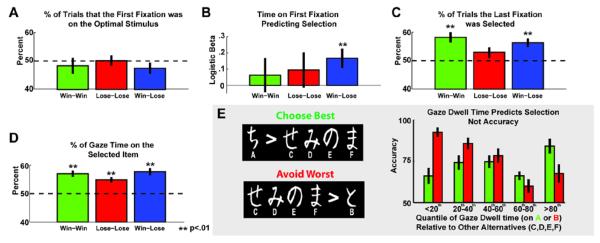Figure 3.
Tests of aDDM predictions of the influence of gaze dwell time on selection. The aDDM predicts that: A) The first stimulus fixated upon should be random with respect to option value. B) The time spent viewing the first option should predict selection. C) The final item fixated upon should be more likely to be selected. D) The relative amount of time gazing on an option should predict selection. E) A novel test of whether gaze time interacts with the value of stimuli. Quantiles reflect the amount of relative time viewing the most optimal (A) and the worst suboptimal (B) stimuli relative to other options (C,D,E,F). Relative viewing time predicted selection in both cases, resulting in improving accuracy for the optimal stimulus but decreasing accuracy for the suboptimal stimulus. Error bars are SEM.

